#king ladislaus
Text




" he's always preferred politics to the alcove... " jadwiga and ladislaus.
#old people in love is one of my fav tropes what can i say#jadwiga of kalisz#queen jadwiga of kalisz#halina łabonarska#halina labonarska#ladislaus the short#ladislaus the elbow-high#king ladislaus#władysław łokietek#wladyslaw lokietek#wiesław wójcik#wieslaw wojcik#korona królów#korona krolow#crown of kings#the kings crown#the crown of the kings#the crown of kings#period drama#period drama edit#perioddramaedit#perioddramagif#period drama gif#costume drama#historical drama#historicalgifs#weloveperioddrama#episode 001#episode 002
10 notes
·
View notes
Text
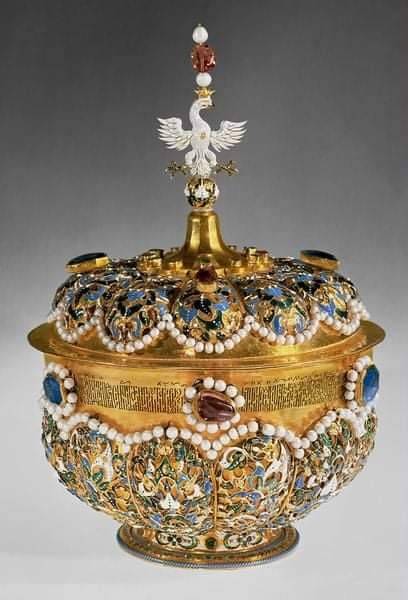
Brotherhood cup ( Bratina ) of King Ladislaus IV from Russia. Kunsthistorisches Museum, Vienna, AUSTRIA
#brotherhood cup#bratina#king ladislaus iv#from russia#kunsthistorisches museum#vienna#austria#europe
26 notes
·
View notes
Text
June 27 is the feast day of St. Ladislaus of Hungary, king

Ignacio de Leon y Escosura: Franciscan Monk Reading
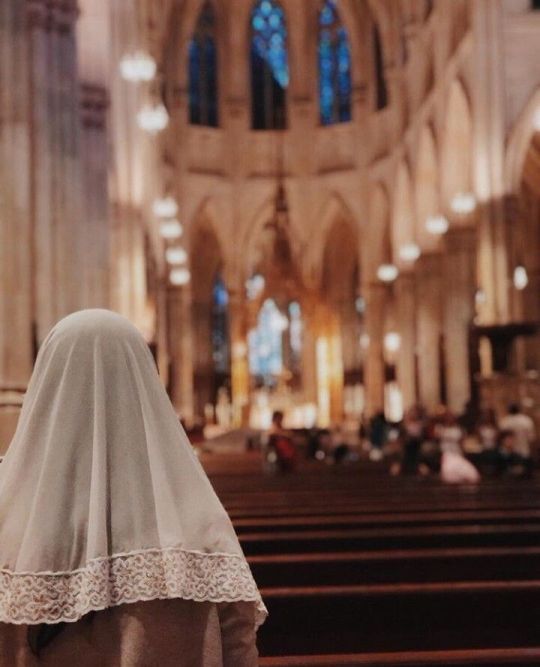
Source of picture: https://tradrevert.tumblr.com
"Blessed are those who fear the Lord, who find great delight in his commands." Psalm 112:1
#saints#king#St. Ladislaus of Hungary#bible quotes#Bible#Psalm 112:1#Blessed are those who fear the Lord#Lord#God#Jesus#Christ#Jesus Christ#Father#Son#Holy Spirit#Holy Trinity#christian religion#faith#hope#love#stress reliever
10 notes
·
View notes
Text
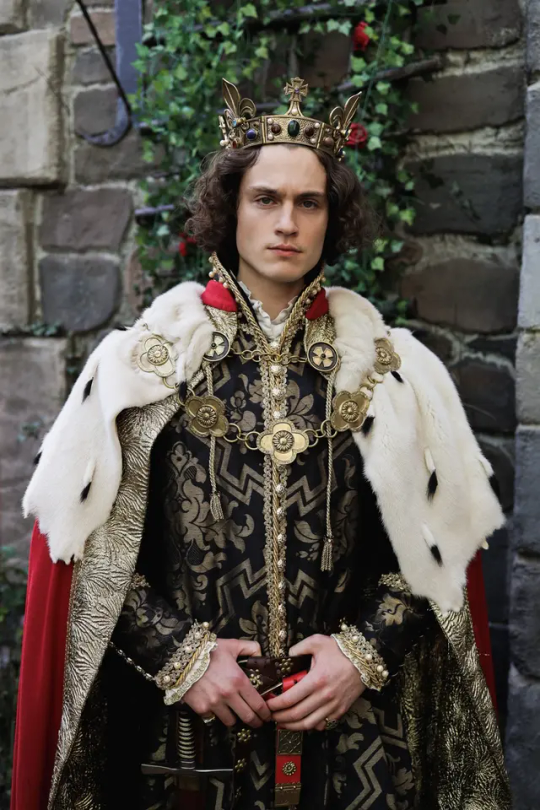
Polish actor Krzysztof Świłpa as Władysław III of Poland (31 October 1424 – 10 November 1444), also known as Władysław (Ladislaus) III Jagiellon/Władysław of Varna – King of Poland, Hungary and Croatia as well as Supreme Duke of the Grand Duchy of Lithuania
"[...] it was from his reign that the thinking of Poland as the “bulwark of Christianity” started to develop, so popular later in the 16th and 17th century. In the 15th century, during the reign of Władysław III, the term “bulwark” referred rather to Hungary, threatened by the progressing Turkish expansion, but it was precisely for this purpose that the young king of Poland accepted the Hungarian crown – in order to fight for defending the Kingdom of Hungary. Military successes during the so-called “long campaign” (1443/1444) resulted in the fact that he individually became to be referred to as a “bulwark of the entire Christian Commonwealth” – and not by somebody else but by Francesco Filelfo, one of the greatest snobs, but also the most outstanding erudite humanist of the Italian Renaissance, who was sought after by the most outstanding people of the time, including monarchs and even the pope. Prof. Janusz Tazbir correctly notices that it was at that time that the term antemurale Christianitatis – already widespread in Europe – was for the first time used towards the Polish ruler (!) and not the Kingdom of Poland. For the achieved victories, Władysław III as the first Polish ruler received from the Pope a blessed sword – a special distinction for rulers who distinguished themselves in fighting for the defence of Christian faith". (© Ewa Srebro, Maria Curie Skłodowska University in Lublin)

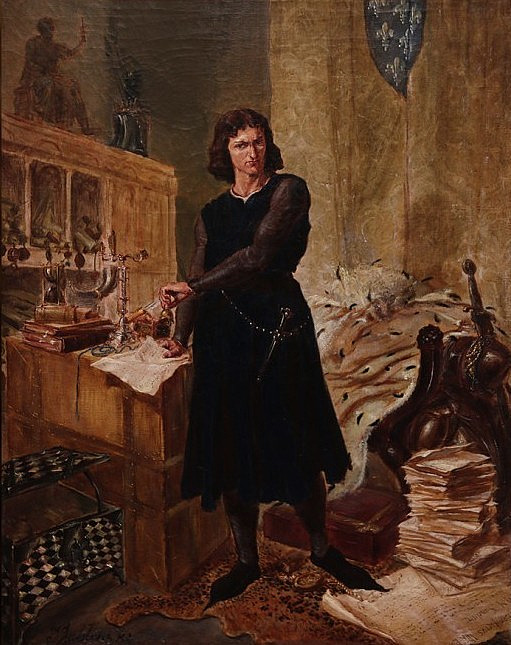
1) Władysław III depicted in a 15th-century prayerbook, 2) Władysław III by Izydor Jabłoński
#władysław warneńczyk#monarchy#ladislaus of varna#krzysztof świłpa#wladyslaw of varna#władysław of varna#poland#hungary#polish history#jagiellonian dynasty#royalty#catholic#catholicism#roman catholic#roman catholicism#15th century#christianity#christian#kingdom of poland#władysław jagiellończyk#historyblr
11 notes
·
View notes
Text

Saint Ladislaus of Hungary, “the Knight-King”: Polish-born Árpádian prince, military commander, Duke of Bihar, King of Hungary and Croatia, legal reformer, father of Saint Irene (Piroska), and supporter of the Benedictine Order—who died at Nitra in 1095.
#st. Ladislaus #san Ladislao de Hungría
166 notes
·
View notes
Text

T
he herm of Saint Ladislaus
SACRAL RELICS
The herm means head-reliquary. In this case, it holds Saint Ladislaus King’s sculpture and we definitely can say that it is the most valuable piece of Hungarian metalsmithing.
The head of the herm is made of gilded, embossed silver. The sculpted reliquary was put inside, in a silver case. The work on the shoulder and chest was crafted with the wire enamel technique. This technique is from 14th century of Byzantium which from there spread to other parts of Europe thanks to Venice. And what is the wire enamel?
Artisans put plates on the subject they are decorating and they solder twisted silver wire to make subdivisions. Then they fill the subdivisions with enamel. While the enamel burns out, it shrinks and the twisted silver wire bulks from the surface.
Experts have argued a lot about the makers of the herm. Some think it was made by Márton Kolozsvári and György Kolozsvári and portrait of III. Béla is seen in the herm by that group. Saint Ladislaus was blessed during III. Béla’s reign. The others think that the head part was made around the 12th-13thcentury at Dénes master’s workshop.
We know as following the old traditions his grave was opened and his head and arms were put in separated shrines so they could make them religious relics before he became blessed in 1192. The next time it is mentioned in records was in 1273 that his sculpture was kept in the shrine in the Cathedral of Nagyvárad where Saint Ladislaus was buried. They used it at the vows. According to one of King Zsigmond’s certificates the herm was destroyed in the great fire of 1406 but the relic survived it. This is when the new herm was made with the technique mentioned earlier between 1406 and 1443. We know this because they held the herm under the tower of the cathedral in Nagyvárad. This tower collapsed but the herm did not get damaged at all.
According to legend Saint Ladislaus’ grave was robbed in 1565 but Bishop Demeter Náprági was able to get the shrine back. When he needed to leave Várad because of the persecution of the catholic people, he took the shrine with him to Gyulafehérvár, Bratislava and in 1607 to Győr. Not too long after Bishop Walter Lynch arrived in Győr and brought the Weeping Madonna painting that wept blood.
Bishop Demeter restored it in Prague. This is when the roller neck and the neck ring got on it that we can see today and this is when its gothic crown was changed. The crown is decorated with Czech grenades and glass and uncolored quartz insets.
Knight King’s personality cult was not foreign for the citizens of Győr before the arrival of Demeter Náprági. Győr town looks at the Saint King as its personal patron since that moment that Győr gave home to this national relic. The story of the earthquake in 1763 belongs to it also. Thanks to that Győr has a tradition since then and the town got a new legend that you can read about here.
They opened the herm for 4 days in 2011. The scientists (doctors, anthropologists and boffins) started a research project to get answers for the following questions during this 4 days: is there a sculpt relic in the herm? Is it a full sculpt or just pieces of it? And does this relic really belong to the Knight King?
The lower jaw and most of his teeth were missing and also little pieces of his sculpture, likely because others took small parts of this relic before as well. János Simon bishop of Győr who became diocesan bishop of Esztergom in 1867 took a tooth of Saint Ladislaus that is kept in a shrine in the Basilica of Esztergom. The shrine was made in Vienna. A little piece of the sculpt and one of the remaining 3 teeth were taken to do some research. The first fact that was figured out that Saint Ladislaus was totally healthy when he died.
The anthropology examination made sure that the herm holds the sculpture of Saint Ladislaus. We can see the colored part on the top of the sculpt and that matches the openings of the shrine that is a strong proof that the original sculpt was kept in it for centuries. Also it shows that it is Saint Ladislaus’ sculpt that it has rugged features of a man who was between 45-55 years old that is shown on the face reconstruction. This face reconstruction is very similar to the one that was made by the sculpt of the III. Béla.
See insights and ads
Boost post
All reactions:
6You, Hungarian Tourism Guide and 4 others
7 notes
·
View notes
Text
Today in Christian History

Today is Monday, August 28th, 2023. It is the 240th day of the year (241st in leap years) in the Gregorian calendar; 125 days remain until the end of the year.
430: Death of St. Augustine of Hippo (pictured above), who, more than any other man since the apostles, stamped the church with his personality and ideas.
1619: Electors choose Ferdinand II to be Holy Roman Emperor. Jesuit-trained, Ferdinand will reject Charles V’s policy that had finally allowed Protestants to exist. Hungry for power, Ferdinand will put down Protestants and anyone who tries to limit his authority. He spurns many chances to end the horrific Thirty Years' War.
1645: Death of Hugo Grotius, a Christian scholar, often titled “the father of international law.”
King Ladislaus IV of Poland convenes a religious conference at Torun (Thorn) in the hope that 26 Catholic, 28 Lutheran, and 24 Calvinist theologians will reach ecumenical consensus for the sake of the nation. Discussion will continue into November but fail dismally.
1737: Death in London of John Hutchinson, who endeavored to confirm Moses’ account of the flood and other natural events in Moses’s Principia.
1862: Dwight L. Moody and Emma Revell marry. Emma will help soften the evangelist’s rough edges, making him a more effective leader.
1892: Baptism in Queensland of Peter Ambuofa, a Solomon Islander who will return to preach the gospel to his own tribe in 1894, but will suffer years of deprivation, sickness, hostility, and threats before a drought brings many to Christ. By 1904 he will have led 200 souls to Christ.
1963: A large civil-rights demonstration (known as The March on Washington) gathers in the United States capital in behalf of African-American civil rights. The march brings together major civil-rights organizations and many religious groups—Catholic, Protestant, and Jewish—and marks the first determined effort by a large number of white clergy to join the cause to end racial discrimination. Rev. Martin Luther King, jr., gives his famous “I Have a Dream” speech.
9 notes
·
View notes
Text
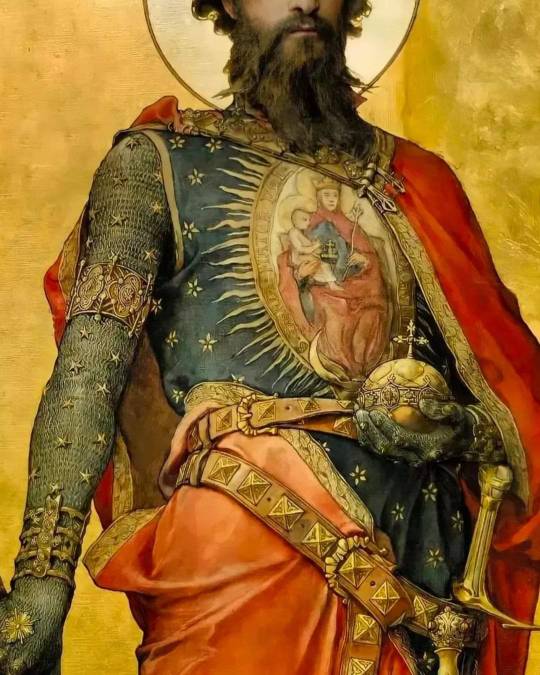
St. Ladislaus King of Hungary (detail) - Ignac Roskovics, 19th Century.

King Saint Ladislaus of Hungary crosses the river Drava to conquer Croatia (painting by Bertalan Székely, 19th century)

St. Ladislaus's reliquary of the late 19th-century (in the Cathedral-Basilica of Oradea, Romania)

After the Battle of Kerlés in 1068, Saint Ladislaus is fighting a duel with a cuman warrior who kidnapped a girl. (Chronicon Pictum, 1358)

Chronica Hungarorum - King Saint Ladislaus of Hungary
10 notes
·
View notes
Text
Partial List of Royal Saints
Saint Abgar (died c. AD 50) - King of Edessa, first known Christian monarch
Saint Adelaide of Italy (931 - 999) - Holy Roman Empress as wife of Otto the Great
Saint Ælfgifu of Shaftesbury (died 944) - Queen of the English as wife of King Edmund I
Saint Æthelberht of Kent (c. 550 - 616) - King of Kent
Saint Æthelberht of East Anglia (died 794) - King of East Anglia
Saint Agnes of Bohemia (1211 - 1282) - Bohemian Princess, descendant of Saint Ludmila and Saint Wenceslaus, first cousin of Saint Elizabeth of Hungary
Saint Bertha of Kent (c. 565 - c. 601) - Frankish Princess and Queen of Kent as wife of Saint Æthelberht
Saint Canute (c. 1042 - 1086) - King of Denmark
Saint Canute Lavard (1096 - 1131) - Danish Prince
Saint Casimir Jagiellon (1458 - 1484) - Polish Prince
Saint Cormac (died 908) - King of Munster
Saint Clotilde (c. 474 - 545) - Queen of the Franks as wife of Clovis I
Saint Cunigunde of Luxembourg (c. 975 - 1033) - Holy Roman Empress as wife of Saint Henry II
Saint Edmund the Martyr (died 869) - King of East Anglia
Saint Edward the Confessor (c. 1003 - 1066) - King of England
Saint Edward the Martyr (c. 962 - 978) - King of the English
Saint Elesbaan (Kaleb of Axum) (6th century) - King of Axum
Saint Elizabeth of Hungary (1207 - 1231) - Princess of Hungary and Landgravine of Thuringia
Saint Elizabeth of Portugal (1271 - 1336) - Princess of Aragon and Queen Consort of Portugal
Saint Emeric (c. 1007 - 1031) - Prince of Hungary and son of Saint Stephen of Hungary
Saint Eric IX (died 1160) - King of Sweden
Saint Ferdinand (c. 1199 - 1252) - King of Castile and Toledo
Blessed Gisela of Hungary (c. 985 - 1065) - Queen Consort of Hungary as wife of Saint Stephen of Hungary
Saint Helena (c. 246 - c. 330) - Roman Empress and mother of Constantine the Great
Saint Henry II (973 - 1024) - Holy Roman Emperor
Saint Isabelle of France (1224 - 1270) - Princess of France and younger sister of Saint Louis IX
Saint Jadwiga (Hedwig) (c. 1373 - 1399) - Queen of Poland
Saint Joan of Valois (1464 - 1505) - French Princess and briefly Queen Consort as wife of Louis XII
Blessed Joanna of Portugal (1452 - 1490) - Portuguese princess who served as temporary regent for her father King Alfonso V
Blessed Karl of Austria (1887 - 1922) - Emperor of Austria, King of Hungary, King of Croatia, and King of Bohemia
Saint Kinga of Poland (1224 - 1292) - Hungarian Princess, wife of Bolesław V of Poland and niece of Saint Elizabeth of Hungary
Saint Ladislaus (c. 1040 - 1095) - King of Hungary and King of Croatia
Saint Louis IX (1214 - 1270) - King of France
Saint Ludmila (c. 860 - 921) - Czech Princess and grandmother of Saint Wenceslaus, Duke of Bohemia
Blessed Mafalda of Portugal (c. 1195 - 1256) - Portuguese Princess and Queen Consort of Castile, sister of Blessed Theresa of Portugal
Saint Margaret of Hungary (1242 - 1270) - Hungarian Princess, younger sister of Saint Kinga of Poland and niece of Saint Elizabeth of Hungary
Saint Margaret of Scotland (c. 1045 - 1093) - English Princess and Queen Consort of Scotland
Blessed Maria Cristina of Savoy (1812 - 1836) - Sardinian Princess and Queen Consort of the Two Sicilies
Saint Matilda of Ringelheim (c. 892 - 968) - Saxon noblewoman and Queen of East Francia as wife of Henry I
Saint Olaf (c. 995 - 1030) - King of Norway
Saint Olga of Kiev (c. 900 - 969) - Grand Princess of Kiev and regent for her son Sviatoslav I, grandmother of Saint Vladimir the Great
Saint Oswald (c. 604 - 642) - King of Northumbria
Saint Radegund (c. 520 - 587) - Thuringian Princess and Frankish Queen
Saint Sigismund of Burgundy (died 524) - King of the Burgundians
Saint Stephen of Hungary (c. 975 - 1038) - King of Hungary
Blessed Theresa of Portugal (1176 - 1250) - Portuguese Princess and Queen of León as wife of King Alfonso IX, sister of Blessed Mafalda
Saint Vladimir the Great (c. 958 - 1015) - Grand Prince of Kiev and grandson of Saint Olga of Kiev
26 notes
·
View notes
Photo

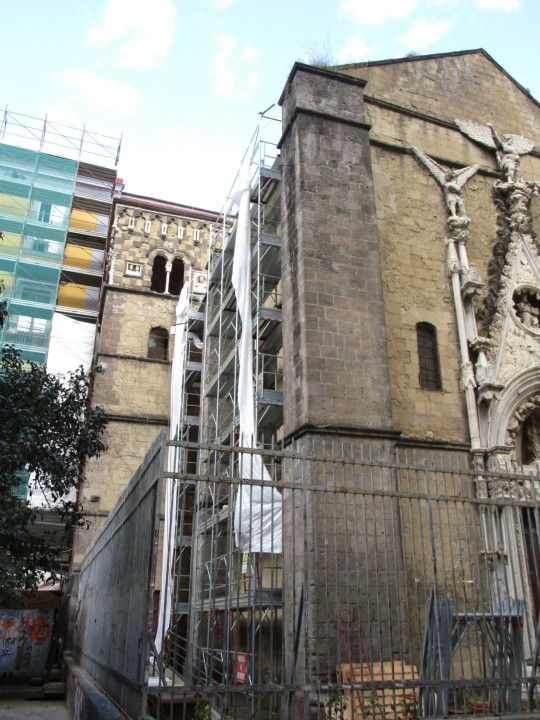
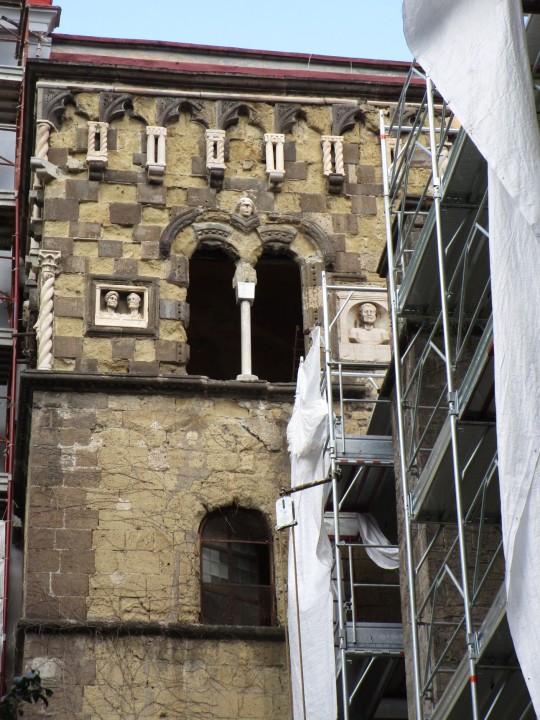

The Pappacoda Chapel in Largo San Giovanni Maggiore in Naples was built in 1415 to house the tombs of the family of Artusio Pappacoda, advisor to King Ladislaus I of Anjou. The outer walls are made of yellow tuff, a type of lava rock that was plentiful in areas of volcanic activity. The upper facade of the belltower incorporates fragments of Roman architecture and sculpture. The chapel’s best feature is the Flamboyant Gothic portal by Antonio Baboccio da Piperno, one of the most famous artists of his time. It is made of white marble and piperno, a dark gray variety of lava rock. The design prominently features the archangels Michael, Raphael, and Gabriel.
The interior of the chapel is not open to the public. In the late 18th century, the 15th century frescoes were erased, and it was stripped of most of the original decorations by a descendant of the Pappacoda family who then had an inscription carved to congratulate himself for restoring the chapel.
Over the years, looters plundered the statues from all the niches of the portal, prompting the caretakers to erect a fence to prevent further vandalism. In 2018 the portal was in danger of collapsing, requiring emergency intervention. As you can see, the preservation of the building was still underway earlier this year.
Photos by Charles Reeza, April 2022
#Gothic architecture#Napoli#Italy#sculpture#stone carving#bas relief#angels#St. Michael#magmatic rock#church#catholic#historic preservation
37 notes
·
View notes
Text
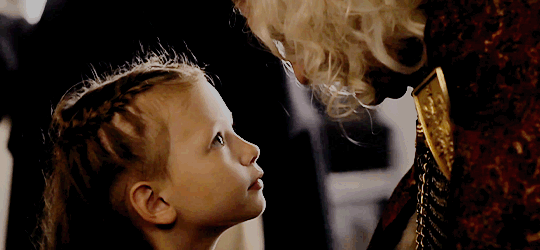

"Do not be afriad. Do not be afraid of anyone. Ever."
king ladislaus the short and his granddaughter, cunigunde.
#cunigunde of poland#kunegunda kazimierzówna#ladislaus the elbow high#ladislaus the short#king ladislaus#korona krolow#korona królów#the crown of the kings#the crown of kings#the kings crown#crown of kings#aldona x casimir#casimir x aldona#ship aesthetic#period drama#weloveperioddrama#period drama edit#perioddramagif#costume drama#costume edit#costumeedit#historical drama#historicalgifs#episode 002
10 notes
·
View notes
Text
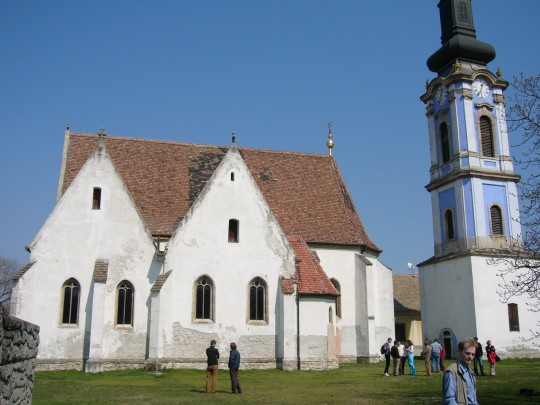

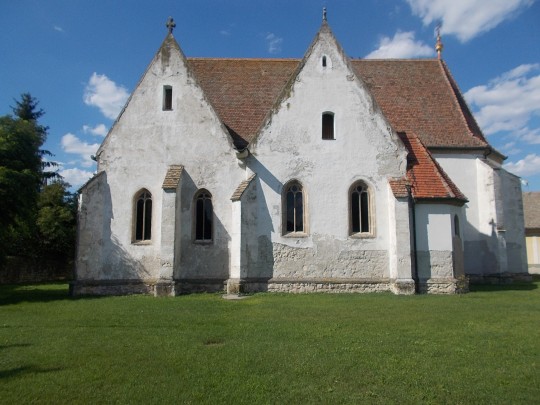


Serbian Orthodox Church in Ráckeve, Hungary. Located 40km south of Budapest on Csepel island, it's the only Serbian church to be built in Gothic style. Monastery was built by Jelena Vukanović, daughter of Uroš I Vukanović (Grand Prince of Serbia). Jelena/Helena/Ilona married Bella II of Hungary becoming Queen of Hungary and mother of Géza II, Ladislaus and Stephen IV, future Kings of Hungary.
17 notes
·
View notes
Text
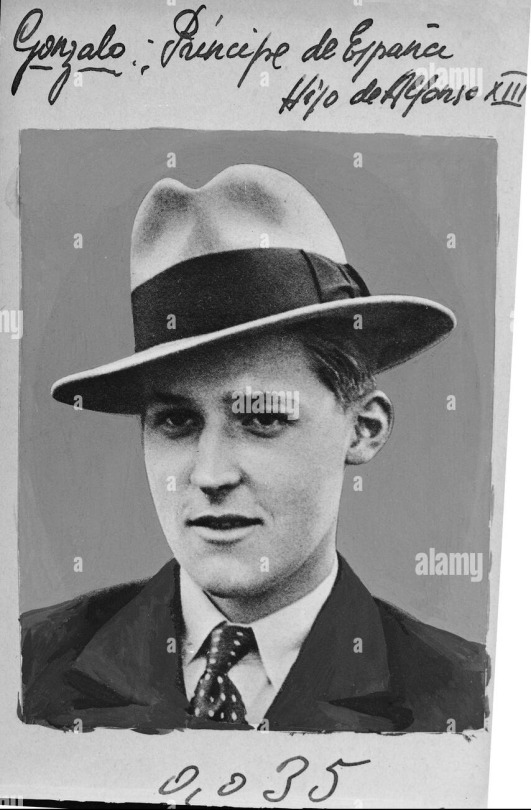
A somewhat rare (in my eyes) ticket or portrait of Infante Gonzalo of Spain the fourth surviving and youngest son of King Alfonso XIII and Queen Victoria Eugenia. (The date is unknown) I don’t know about other Royal enthusiasts but I absolutely love learning about each individual royal and infante Gonzalo is no different. Being a great grandson of Queen Victoria he sadly inherited the “royal disease” known as hemophilia. Because of this he had some ill health but was an active sportsman. In August 1934, Gonzalo was spending the summer holidays with his family at the villa of Count Ladislaus de Hoyos at Pörtschach am Wörthersee in Austria. On the evening of 11 August, Gonzalo and his sister Infanta Beatriz were driving from Klagenfurt to Pörtschach. Near Krumpendorf, Beatriz, who was driving, was forced to swerve to avoid a cyclist (the retired jockey Baron Neimans). The car crashed into a wall. Neither Gonzalo nor Beatriz appeared badly hurt, and so they returned to their villa. Several hours later it became clear that Gonzalo had severe abdominal bleeding. Because he had a weak heart, an operation was ruled out. He tragically died two days later.
Gonzalo was buried in the graveyard at Pörtschach. Later, his body was moved to the Pantheon of the Princes in El Escorial, Spain.
#european royals#spanish royal family#royalty#spanish royalty#infante Gonzalo of Spain#king Alfonso XIII#queen ena of spain#spain royal history#spain#royal children
3 notes
·
View notes
Text
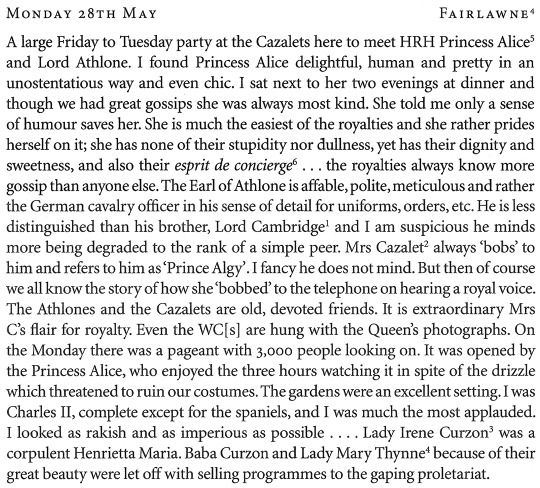
Henry ‘Chips’ Channon: The Diaries (Vol. 1), 1918-38, entry for 28th May 1923
—
Monday 28th May — Fairlawne¹
A large Friday to Tuesday party at the Cazalets here to meet HRH Princess Alice² and Lord Athlone. I found Princess Alice delightful, human and pretty in an unostentatious way and even chic. I sat next to her two evenings at dinner and though we had great gossips she was always most kind. She told me only a sense of humour saves her. She is much the easiest of royalties and she rather prides herself on it; she has none of the stupidity nor dullness, yet has their dignity sweetness, and also their esprit de concierge³ . . . the royalties always know more gossip than anyone else. The Earl of Athlone is affable, polite, meticulous and rather and the German cavalry officer in his sense of detail for uniforms, orders, etc. He is less distinguished than his brother, Lord Cambridge⁴ and I am suspicious he minds more being degraded to the rank of a simple per. Mrs Cazalet⁵ always ‘bobs’ to him and refers to him as ‘Prince Algy’. I fancy he does not mind. But then of course we all know the story of how she ‘bobbed’ to the telephone on hearing a royal voice. The Athlones and the Cazalets are old, devoted friends. It is extraordinary Mrs C’s flair for royalty. Even the WC[s] are hung with the Queen’s photographs. On the Monday there was a pageant with 3,000 people looking on. It was opened by the Princess Alice, who enjoyed the three hours watching it in spite of the drizzle which threatened to ruin our costumes. The gardens were an excellent setting. I was Charles II, complete except for the spaniels, and I was much the most applauded. I looked as rakish and as imperious as possible . . . . Lady Irene Curzon⁶ was a corpulent Henrietta Maria. Baba Curzon and Lady Mary Thynne⁷ because of their great beauty were let off with selling programmes to the gaping proletariat.
—
1. An estate in west Kent, near Tonbridge, owned by the Cazalet family from 1880.
2. Princess Alice Mary Victoria Augusta Pauline (1883-1981), daughter of Prince Leopold, Duke of Albany, youngest son of Queen Victoria; she was therefore the King’s cousin. She married in 1904 Prince Alexander of Teck (1874-1957), brother of the future Queen Mary; his title was anglicised in 1917 after the creation of the House of Windsor and he was granted the earldom of Athlone, after which his wife was known as Princess Alice, Countess of Athlone.
3. The spirit of a concierge; collecting gossip about all who pass through.
4. Adolphus Charles Alexander Albert Edward George Philip Louis Ladislaus, Duke of Teck (1868-1927). Like his brother, he relinquished his German titles in 1917 and, as brother of the Queen Consort, was created 1st Marquess of Cambridge. His younger brother was one rank below him in the peerage.
5. Maud Lucia Heron-Maxwell (1868-1952), married in 1893 William Marshall Cazalet (1865-1932); she was the mother of Victor Cazalet.
6. Mary Irene Curzon (1896-1966), known as Lady Irene Curzon after her father’s advancement to an earldom in 1911, was Lord Curzon’s eldest daughter. On his death in 1925 she inherited the barony of Ravensdale, and in 1958 was enabled to sit in the House of Lords by being granted a life peerage. She never married, declining a proposal from Victor Cazalet.
7. Lady Mary Beatrice Thynne (1903-74), third daughter of the 5th Marquess of Bath; she married in 1927 Charles Wilson (1904-74), 3rd Baron Nunburnholme.
#chips channon#channon diaries#1923#1920s#william cazalet#maud cazalet#alice athlone#alexander athlone#adolphus cambridge#irene ravensdale#baba metcalfe#mary nunburnholme#🕰️
4 notes
·
View notes
Photo
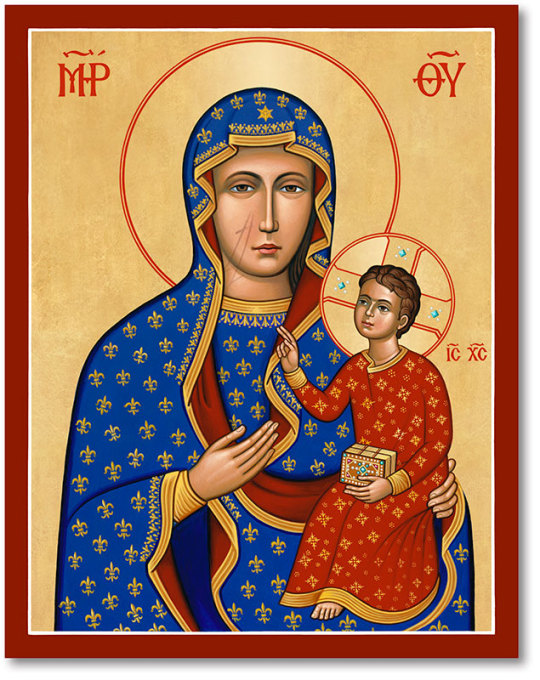
While many different Virgin Mary icons exist, legend attributes the creation of the icon of Our Lady of Czestochowa to St. Luke, the first Christian iconographer. St. Helena is said to have located the icon during her visit to the Holy Land and brought it to Constantinople in the fourth century. In a critical battle with the Saracens, this icon was displayed from the walls of the city and the Saracens were routed. The icon was eventually owned by Charlemagne and changed hands many times, eventually making its way to Poland.
During the reign of St. Ladislaus, King of Poland, in the fifteenth century, the Tartars stole and vandalized the image, but the holy icon was recovered and restored.
The legend concerning the two scars on the Black Madonna's right cheek is that the Hussites stormed the monastery where the icon resided in 1430, plundering the sanctuary. Among the items stolen was the icon. After putting it in their wagon, the Hussites tried to get away but their horses refused to move. They threw the portrait down to the ground and one of the plunderers drew his sword upon the image and inflicted two deep strikes. When the robber tried to inflict a third strike, he fell to the ground and writhed in agony until his death.
Many times in the following centuries, the Holy Virgin demonstrated her miraculous protection of the Polish people through her icon. The Our Lady of Czestochowa icon is sometimes referred to as the "Black Madonna" because of the black color of the original, caused by age and the accumulated soot of the ages.
From Monastery Icons
28 notes
·
View notes
Text
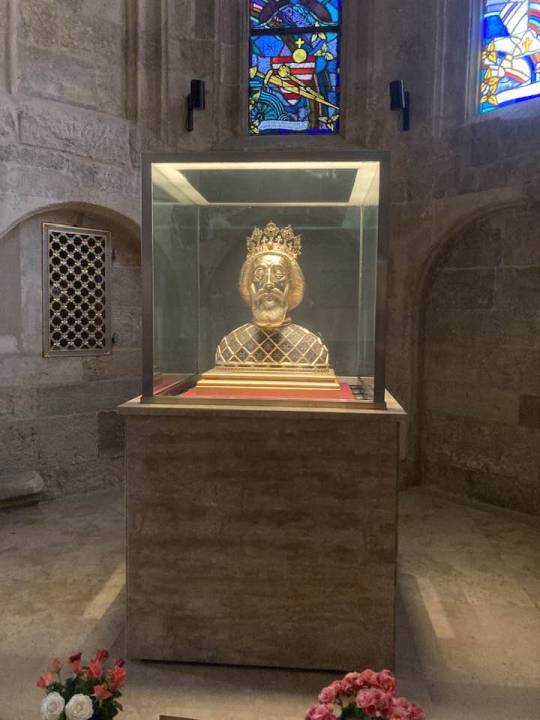
The herm of Saint Ladislaus
SACRAL RELICS
The herm means head-reliquary. In this case, it holds Saint Ladislaus King’s sculpture and we definitely can say that it is the most valuable piece of Hungarian metalsmithing.
The head of the herm is made of gilded, embossed silver. The sculpted reliquary was put inside, in a silver case. The work on the shoulder and chest was crafted with the wire enamel technique. This technique is from 14th century of Byzantium which from there spread to other parts of Europe thanks to Venice. And what is the wire enamel?
Artisans put plates on the subject they are decorating and they solder twisted silver wire to make subdivisions. Then they fill the subdivisions with enamel. While the enamel burns out, it shrinks and the twisted silver wire bulks from the surface.
Experts have argued a lot about the makers of the herm. Some think it was made by Márton Kolozsvári and György Kolozsvári and portrait of III. Béla is seen in the herm by that group. Saint Ladislaus was blessed during III. Béla’s reign. The others think that the head part was made around the 12th-13thcentury at Dénes master’s workshop.
We know as following the old traditions his grave was opened and his head and arms were put in separated shrines so they could make them religious relics before he became blessed in 1192. The next time it is mentioned in records was in 1273 that his sculpture was kept in the shrine in the Cathedral of Nagyvárad where Saint Ladislaus was buried. They used it at the vows. According to one of King Zsigmond’s certificates the herm was destroyed in the great fire of 1406 but the relic survived it. This is when the new herm was made with the technique mentioned earlier between 1406 and 1443. We know this because they held the herm under the tower of the cathedral in Nagyvárad. This tower collapsed but the herm did not get damaged at all.
According to legend Saint Ladislaus’ grave was robbed in 1565 but Bishop Demeter Náprági was able to get the shrine back. When he needed to leave Várad because of the persecution of the catholic people, he took the shrine with him to Gyulafehérvár, Bratislava and in 1607 to Győr. Not too long after Bishop Walter Lynch arrived in Győr and brought the Weeping Madonna painting that wept blood.
Bishop Demeter restored it in Prague. This is when the roller neck and the neck ring got on it that we can see today and this is when its gothic crown was changed. The crown is decorated with Czech grenades and glass and uncolored quartz insets.
Knight King’s personality cult was not foreign for the citizens of Győr before the arrival of Demeter Náprági. Győr town looks at the Saint King as its personal patron since that moment that Győr gave home to this national relic. The story of the earthquake in 1763 belongs to it also. Thanks to that Győr has a tradition since then and the town got a new legend that you can read about here.
They opened the herm for 4 days in 2011. The scientists (doctors, anthropologists and boffins) started a research project to get answers for the following questions during this 4 days: is there a sculpt relic in the herm? Is it a full sculpt or just pieces of it? And does this relic really belong to the Knight King?
The lower jaw and most of his teeth were missing and also little pieces of his sculpture, likely because others took small parts of this relic before as well. János Simon bishop of Győr who became diocesan bishop of Esztergom in 1867 took a tooth of Saint Ladislaus that is kept in a shrine in the Basilica of Esztergom. The shrine was made in Vienna. A little piece of the sculpt and one of the remaining 3 teeth were taken to do some research. The first fact that was figured out that Saint Ladislaus was totally healthy when he died.
The anthropology examination made sure that the herm holds the sculpture of Saint Ladislaus. We can see the colored part on the top of the sculpt and that matches the openings of the shrine that is a strong proof that the original sculpt was kept in it for centuries. Also it shows that it is Saint Ladislaus’ sculpt that it has rugged features of a man who was between 45-55 years old that is shown on the face reconstruction. This face reconstruction is very similar to the one that was made by the sculpt of the III. Béla.
5 notes
·
View notes